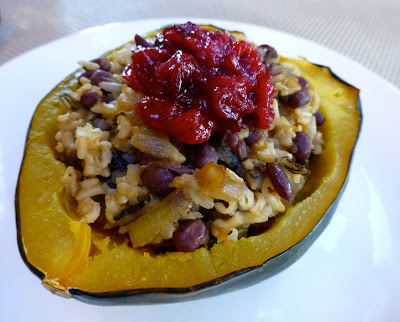 |
| Did you know that buckwheat noodles are gluten free? Follow Foods For Long Life on FACEBOOK . |
Buckwheat is Not Wheat!
Although "wheat" is in the name, buckwheat is not related to wheat. Buckwheat Fagopyrum esculentum is not part of the cereal grain family but is from a broad leaf plant in the Polygonaceae family. Soba noodles, made from 100% buckwheat, are suitable for those on a gluten-free diet as long as they haven't been cross contaminated during processing.
I love the chewy texture of these noodles. I prefer them over Udon noodles and always have a package of them in the pantry. Soba noodles are low in fat and high in protein and contain all the essential amino acids. They also contain thiamin, folate niacin, manganese, magnesium, phosphorus and iron.
 |
| a 2 oz serving of buckwheat soba provides: 200 calories 1 g total fat zero saturated fat and cholesterol 6 g protein 3 g dietary fiber 43 g carbohydrates |
Time for Soup
It's getting cold and although one third of my diet still consists of raw fruits and vegetables, most of my diet, in the cold months, is cooked. I almost always have a pot of hot soup on the stove.
Here's a recipe that can stand alone with just the veggies, shiitake mushrooms and soba noodles but you can also add slices of tofu or the protein of your choice to make it even more hardy.
You can make this meal using just 2 pots: a 3-quart saucepan to make the broth and a 5-quart soup pot.
Veggie and Soba Noodle Soup
Vegan, Gluten Free
[makes 4 servings]
For the broth
Stems from 1/4 pound shiitake mushrooms used in soup
8 cups water
2 cloves garlic, smashed
2 tablespoons gluten free, low sodium soy sauce
1 carrot, cut in large slices
1 or 2 stalks celery, cut in large slices
2 large slices of onion (top and bottom with skin)
1 teaspoon grated fresh ginger
For the soup
4 cups small broccoli florets
8 ounce package of buckwheat soba noodles
1 tablespoon sesame oil
3/4 cups thinly sliced onions
1 small red bell pepper, cleaned, quartered and sliced
1/4 pound shiitake mushrooms, stems reserved for broth, caps cut in half
1 1/2 cups peeled and sliced carrots
Strained broth from above
1/2 teaspoon salt, or to taste
4 or more slices raw jalapeño
1/4 cup fresh cilantro
Make the broth. Remove the stems from the shiitake mushrooms and place them and all of the broth ingredients in a 3-quart saucepan and bring to a boil. Reduce heat, cover and simmer for 30 minutes. Set aside.
 |
| It's easy to make your own broth. This broth makes use of the mushroom stems and the top and bottom of the onion. |
While the broth simmers, prepare the vegetables and noodles.
Place a steamer basket in a 5-quart soup pot filled with 2 inches of water. Place the broccoli in the steamer basket and cook, covered, on high heat until fork tender. Remove the broccoli from the pot immediately so that it doesn't overcook. Set aside.
 |
| Cut the broccoli into very small florets. Steam briefly until fork tender and remove from heat. |
Remove the steamer basket from the pot and fill the soup pot with fresh water. Boil water and cook the soba noodles according to the directions on the package. Drain the noodles in a colander and rinse them well as soba noodles can be quite starchy. Set them aside. Wipe out the soup pot with a towel to dry.
Heat the sesame oil in the soup pot and cook the onions on medium heat until they begin to soften, about 4 minutes.
Add the peppers, shiitake mushrooms and carrots and cook for another 4 minutes.
 |
| Cook the onions, peppers, mushrooms and carrots. |
Strain the broth and pour it into the soup pot along with the slices of jalapeño. Simmer until the carrots are tender, about 10 minutes. Add salt if desired.
Add the cooked broccoli and soba noodles to the soup pot and heat for several minutes until warm.
Divide into 4 soup bowls, top with fresh cilantro and serve.
 |
Per serving: 316 calories, 5 g total fat, 0.6 g saturated fat, 51 mg omega-3 and 1.6 g omega-6 fatty acids, 11 g protein, 60 g carbohydrates, 8.3 g dietary fiber and 717 mg of sodium (with the additional 1/2 teaspoon of salt - 427 mg sodium without it).






































